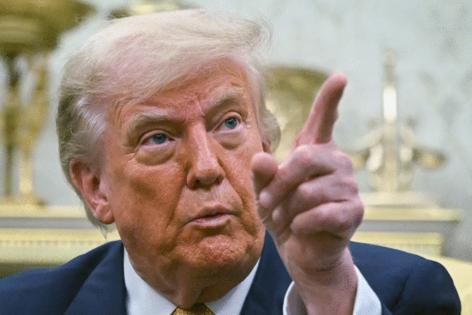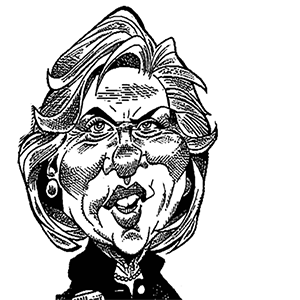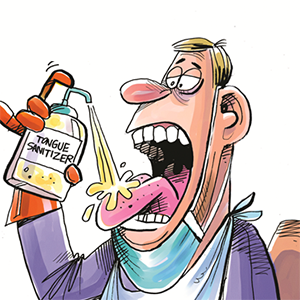Trump says he moved US nuclear subs after barbs with Russia
Published in News & Features
WASHINGTON — President Donald Trump said the U.S. is moving two nuclear submarines to respond to what he called “highly provocative statements” from former Russian President Dmitry Medvedev.
“I have ordered two Nuclear Submarines to be positioned in the appropriate regions, just in case these foolish and inflammatory statements are more than just that,” Trump said in a social media post Friday. “Words are very important, and can often lead to unintended consequences, I hope this will not be one of those instances.”
Trump, speaking to reporters later Friday, suggested he was acting out of caution, saying that “we had to do that, we just have to be careful and a threat was made and we didn’t think it was appropriate.”
“I have to be very careful, so I do that on the basis of safety for our people,” he said. “We’re going to protect our people.”
Asked what Medvedev had said that angered him, Trump responded, “You just have to read what he said. He was talking about nuclear. When you talk about nuclear, we have to be prepared, and we’re totally prepared.”
The office of the Secretary of Defense referred requests for more details to the White House and declined to comment on whether Trump was referring to submarines armed with nuclear weapons rather than simply nuclear-powered vessels.
Defense Secretary Pete Hegseth, on his personal social media account, shared a screenshot of Trump’s post without comment.
Officials at the Kremlin didn’t immediately respond to a request for comment.
Trump’s post Friday was the latest in a heated public exchange with Medvedev, who currently serves as Russia’s deputy chairman of the security council. Medvedev, in a July 28 post on X, had warned Trump that “each new ultimatum is a threat and a step towards war. Not between Russia and Ukraine, but with his own country.”
West Texas Intermediate crude, the U.S. benchmark for oil, fell as much as 3.2% Friday after weak jobs and manufacturing data, although prices later stabilized following Trump’s comments on the potential threat from Russia. His hardening stance toward Russia in recent weeks is raising speculation that the U.S. will impose tariffs on nations buying crude from Moscow, which could tighten global supplies.
Trump has said he expects to hit Russia with sanctions after providing a new deadline — which falls on Aug. 8 — for Russian President Vladimir Putin to halt the war in Ukraine.
In a social media post on Thursday, Trump assailed Russia and India — a major customer for Russian energy — and lashed out at Medvedev, calling him a “failed” former president who needed to “watch his words.”
“He’s entering very dangerous territory!” Trump had said.
Medvedev responded in a post to Telegram hours later in which he said that Russia would continue in its own way, jabbing at Trump.
Trump’s interactions with Medvedev intensified in the same week that U.S. Secretary of State Marco Rubio dismissed the Russian official as “not a relevant player.”
Jennifer Kavanagh, senior fellow and director of military analysis at Washington-based think tank Defense Priorities, said the social media exchange was an “unhelpful and a very risky way to do international diplomacy.”
The U.S. typically has four or five submarines on “hard alert” at any time, Kavanagh said, downplaying the likelihood that Trump significantly changed U.S. nuclear posture.
“The likelihood is there are already nuclear submarines positioned in locations where they could strike Russia if necessary,” she said.
Putin also has dismissed Trump’s latest effort to pressure him into peace, saying that his war goals in Ukraine are unchanged and dismissing calls for a ceasefire. Putin said that recent talks between Ukraine and Russia in Turkey were “positive in general” and dismissed frustration over the war by casting it as the result of “excessive expectations,” without directly naming Trump.
Trump campaigned in the 2024 election on a pledge to quickly bring Russia’s war in Ukraine — now well into its fourth year — to an end. Those efforts have failed to materialize with Putin only making maximalist demands for Ukrainian territory and rebuffing calls for face-to-face discussions with Ukraine’s leader Volodymyr Zelenskyy.
Matthew Kroenig, vice president and senior director at the Scowcroft Center for Strategy and Security at the Atlantic Council, cast Trump’s Friday post as a “brilliant move” and “all part of trying to force Putin to the negotiating table.”
Russian Foreign Minister Sergei Lavrov on Friday had said it was encouraging that U.S. officials remained open to continuing the conversation — a message posted shortly before Trump’s submarine announcement.
“The substantive discussions on the Ukrainian issue that have been taking place between Moscow and Washington since the beginning of the year have been very useful and have yielded results,” Lavrov said in comments published on the ministry’s website.
Trump had said on Thursday that his special envoy Steve Witkoff would head to Moscow after wrapping up a trip to Middle East, though he did not provide an exact date for the visit.
The White House didn’t immediately respond to a request for comment on whether Witkoff still planned to travel to Russia.
_____
(Courtney McBride, Ilya Arkhipov, Eric Martin, Gregory White, Natalia Drozdiak and Michael Ball contributed to this report.)
©2025 Bloomberg L.P. Visit bloomberg.com. Distributed by Tribune Content Agency, LLC.







Comments